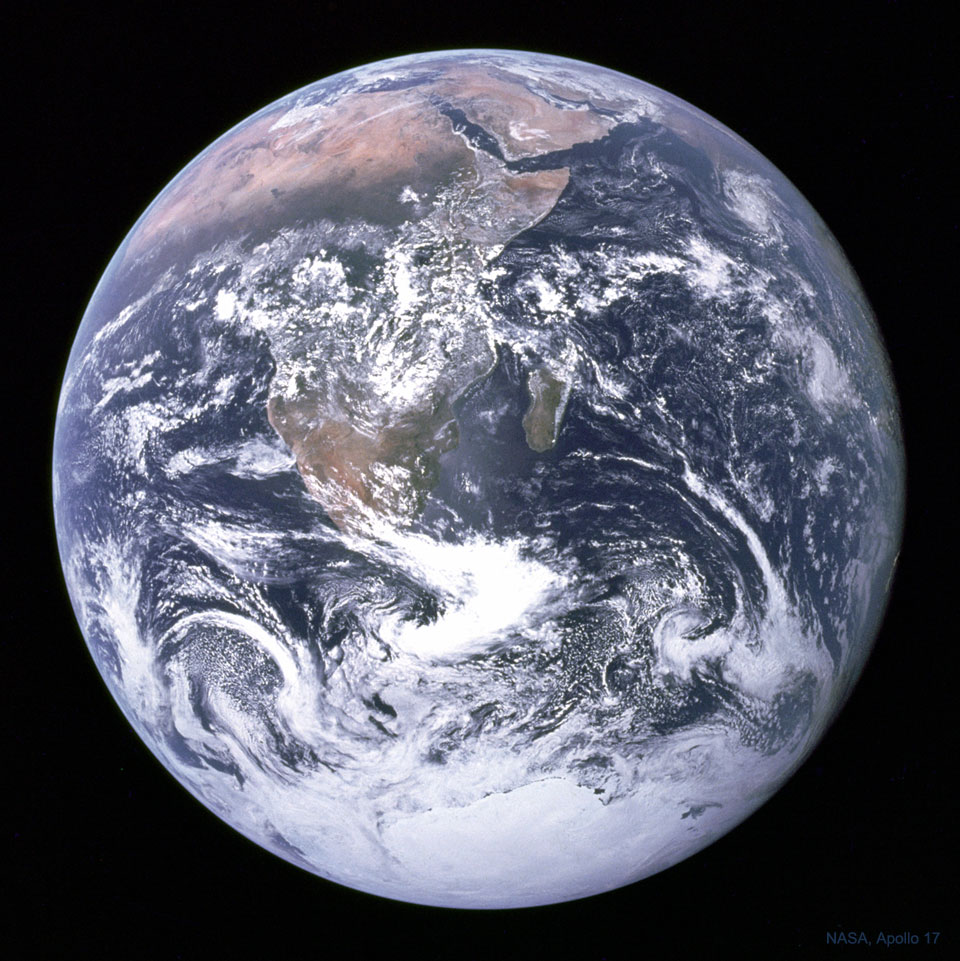06. February 2022
地球這粒藍色大理石

探索宇宙1!逐工會揀一幅無仝款 ê 影像抑是相片,𤆬你熟似咱這个迷人 ê 宇宙,閣有專業天文學者2為你3解說4。
- 原始文章:Blue Marble Earth
- 影像來源:NASA, Apollo 17 Crew
- 台文翻譯:An-Li Tsai (NCU)
[漢羅] 地球這粒藍色大理石
歡迎來到咱 ê 地球,這是太陽這粒恆星 ê 第三粒行星。 地球 是 球形 ê,伊主要 ê 組成成份 是岩石。 地球表面 有 70 葩是水。 伊有一重 薄薄 ê 大氣層,主要 ê 組成成份是 窒素 kah 酸素。 地球去 hŏng 叫做是 藍色大理石。 這張相片 是 1972 年 阿波羅 17 號太空船 翕 ê,翕著 非洲 kah 南極洲。 這是目前為止 上濟人分享 ê 地球相片。 地球 有一粒大衛星,月球。 伊 ê 直徑差不多是地球 ê 1/4。 毋閣 ùi 地球面頂看,月球 kah 太陽 ê 角寸尺差不多是平大。 地球面頂有 足濟液態水,予伊有當支持伊面頂 濟濟款 ê 性命形態。 包括一寡較懸智慧 ê 生物,比論講 海豬 kah 人類。 歡迎你來阮 ê 地球 𨑨迌。
[POJ] Tē-kiû chit-lia̍p Nâ-sek tāi-lí-chio̍h
Hoan-gêng lâi-kàu lán ê Tē-kiû, che sī Thài-iông chit-lia̍p hêng-chhiⁿ ê tē-saⁿ-lia̍p kiâⁿ-chhiⁿ. Tē-kiû sī kiû-hêng ê, i chú-iàu ê cho͘-sêng sêng-hūn sī giâm-chio̍h. Tē-kiû piáu-bīn ū chhit-cha̍p pha sī chúi. I ū chi̍t-têng po̍h-po̍h-ê tōa-khì-chân, chú-iàu ê cho͘-sêng sêng-hūn sī chek-sò͘ kah sng-sò͘. Tē-kiû khì hŏng kiò-chò sī nâ-sek tāi-lí-chio̍h. Chit-tiuⁿ siòng-phìⁿ sī i̍t-kiú-chhit-jī nî A-pho-lô cha̍p-chhit hō thài-khong-chûn hip ê, hip-tio̍h Hui-chiu kah Lâm-ke̍k-chiu. Che sī bo̍k-chêng ûi-chí siōng chē lâng hun-hióng ê Tē-kiû siòng-phìⁿ. Tē-kiû ū chi̍t-lia̍p tōa ūi-chhiⁿ, Goe̍h-kiû. I ê ti̍t-kèng chha-put-to sī Tē-kiû ê sì-hun-chi-it. M̄-koh ùi Tē-kiû bīn-téng khòaⁿ, Goe̍h-kiû kah Thài-iông ê kak-chhùn-chhioh chha-put-to sī pêⁿ-tōa. Tē-kiû bīn-téng ū chiok-chōe e̍k-thài-chúi, hō͘ i ū-tàng chi-chhî i bīn-téng chē-chē-khoán ê sìⁿ-miā hêng-thài. Pau-koah chi̍t-kóa khah koân tì-hūi ê seng-bu̍t, pí-lūn-kóng hái-ti kah jîn-lūi. Hoan-gêng lí lâi gún ê Tē-kiû chhit-thô.
[KIP] Tē-kiû tsit-lia̍p Nâ-sik tāi-lí-tsio̍h
Huan-gîng lâi-kàu lán ê Tē-kiû, tse sī Thài-iông tsit-lia̍p hîng-tshinn ê tē-sann-lia̍p kiânn-tshinn. Tē-kiû sī kiû-hîng ê, i tsú-iàu ê tsoo-sîng sîng-hūn sī giâm-tsio̍h. Tē-kiû piáu-bīn ū tshit-tsa̍p pha sī tsuí. I ū tsi̍t-tîng po̍h-po̍h-ê tuā-khì-tsân, tsú-iàu ê tsoo-sîng sîng-hūn sī tsik-sòo kah sng-sòo. Tē-kiû khì hŏng kiò-tsò sī nâ-sik tāi-lí-tsio̍h. Tsit-tiunn siòng-phìnn sī i̍t-kiú-tshit-jī nî A-pho-lô tsa̍p-tshit hō thài-khong-tsûn hip ê, hip-tio̍h Hui-tsiu kah Lâm-ki̍k-tsiu. Tse sī bo̍k-tsîng uî-tsí siōng tsē lâng hun-hióng ê Tē-kiû siòng-phìnn. Tē-kiû ū tsi̍t-lia̍p tuā uī-tshinn, Gue̍h-kiû. I ê ti̍t-kìng tsha-put-to sī Tē-kiû ê sì-hun-tsi-it. M̄-koh uì Tē-kiû bīn-tíng khuànn, Gue̍h-kiû kah Thài-iông ê kak-tshùn-tshioh tsha-put-to sī pênn-tuā. Tē-kiû bīn-tíng ū tsiok-tsuē i̍k-thài-tsuí, hōo i ū-tàng tsi-tshî i bīn-tíng tsē-tsē-khuán ê sìnn-miā hîng-thài. Pau-kuah tsi̍t-kuá khah kuân tì-huī ê sing-bu̍t, pí-lūn-kóng hái-ti kah jîn-luī. Huan-gîng lí lâi gún ê Tē-kiû tshit-thô.
[English] Blue Marble Earth
Welcome to planet Earth, the third planet from a star named the Sun. The Earth is shaped like a sphere and composed mostly of rock. Over 70 percent of the Earth's surface is water. The planet has a relatively thin atmosphere composed mostly of nitrogen and oxygen. The featured picture of Earth, dubbed The Blue Marble, was taken from Apollo 17 in 1972 and features Africa and Antarctica. It is thought to be one of the most widely distributed photographs of any kind. Earth has a single large Moon that is about 1/4 of its diameter and, from the planet's surface, is seen to have almost exactly the same angular size as the Sun. With its abundance of liquid water, Earth supports a large variety of life forms, including potentially intelligent species such as dolphins and humans. Please enjoy your stay on planet Earth.
詞彙學習
| 漢羅 | POJ | KIP | 華語 | English |
|---|---|---|---|---|
| 窒素 | chek-sò͘ | tsik-sòo | 氮 | nitrogen |
| 酸素 | sǹg-sò͘ | sǹg-sòo | 氧 | oxygen |
| 南極洲 | Lâm-ke̍k-chiu | Lâm-ki̍k-tsiu | 南極洲 | Antarctica |
| 液態水 | e̍k-thài-chúi | i̍k-thài-tsuí | 液態水 | liquid water |
| 大理石 | tāi-lí-chio̍h | tāi-lí-tsio̍h | 大理石 | Marble |
| 角寸尺 | kak-chhùn-chhioh | kak-tshùn-tshioh | 角尺寸 | angular size |